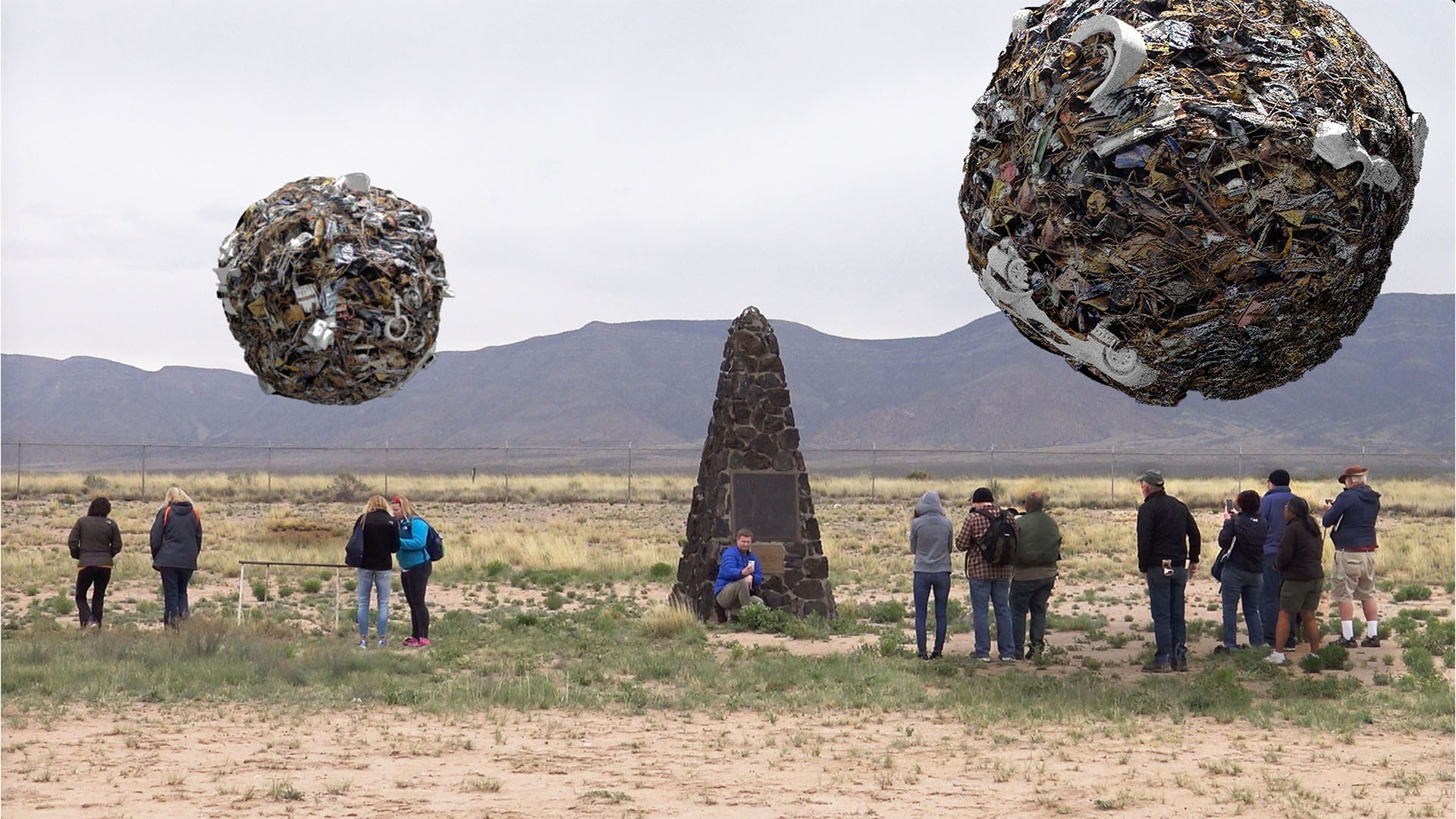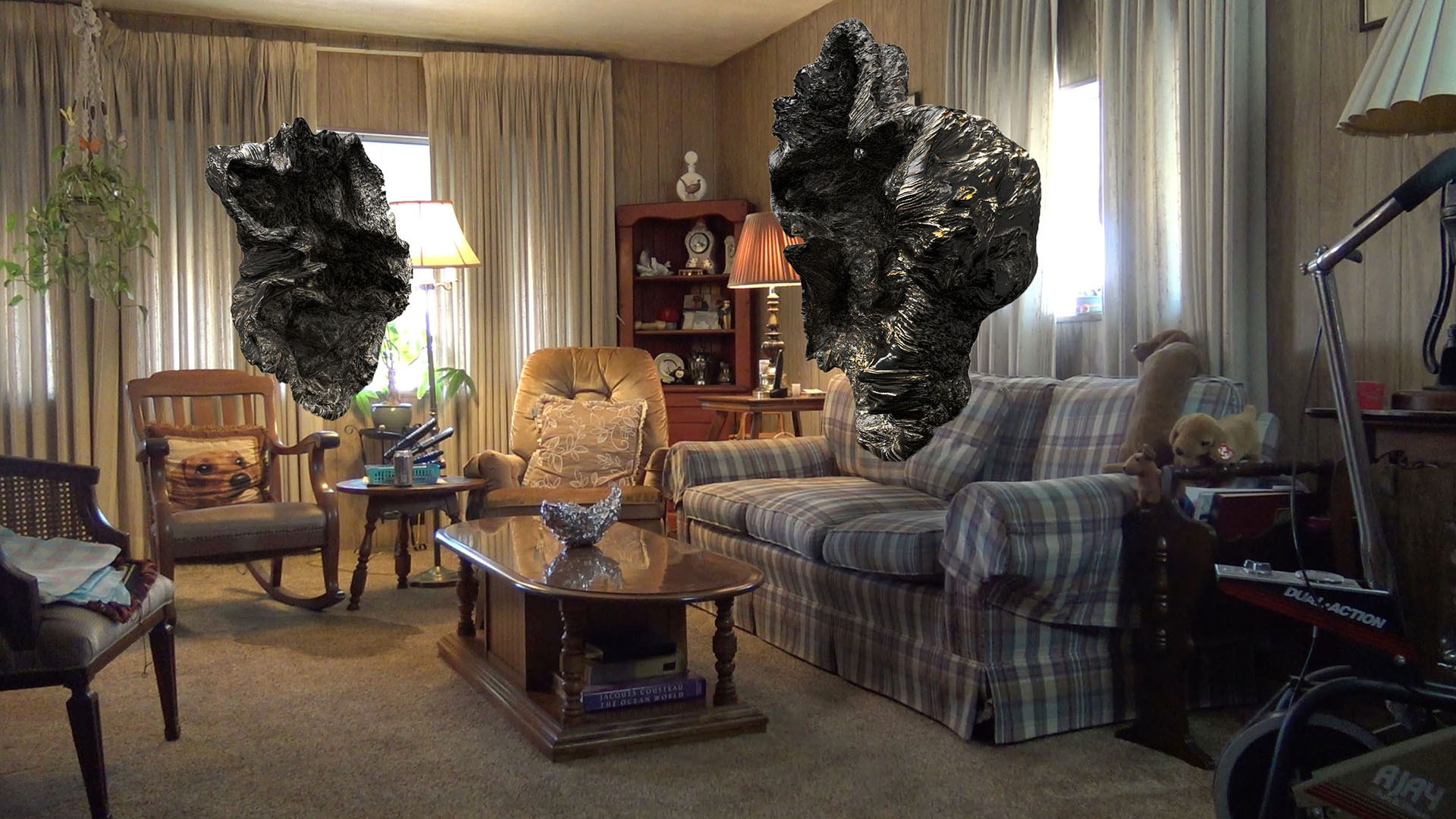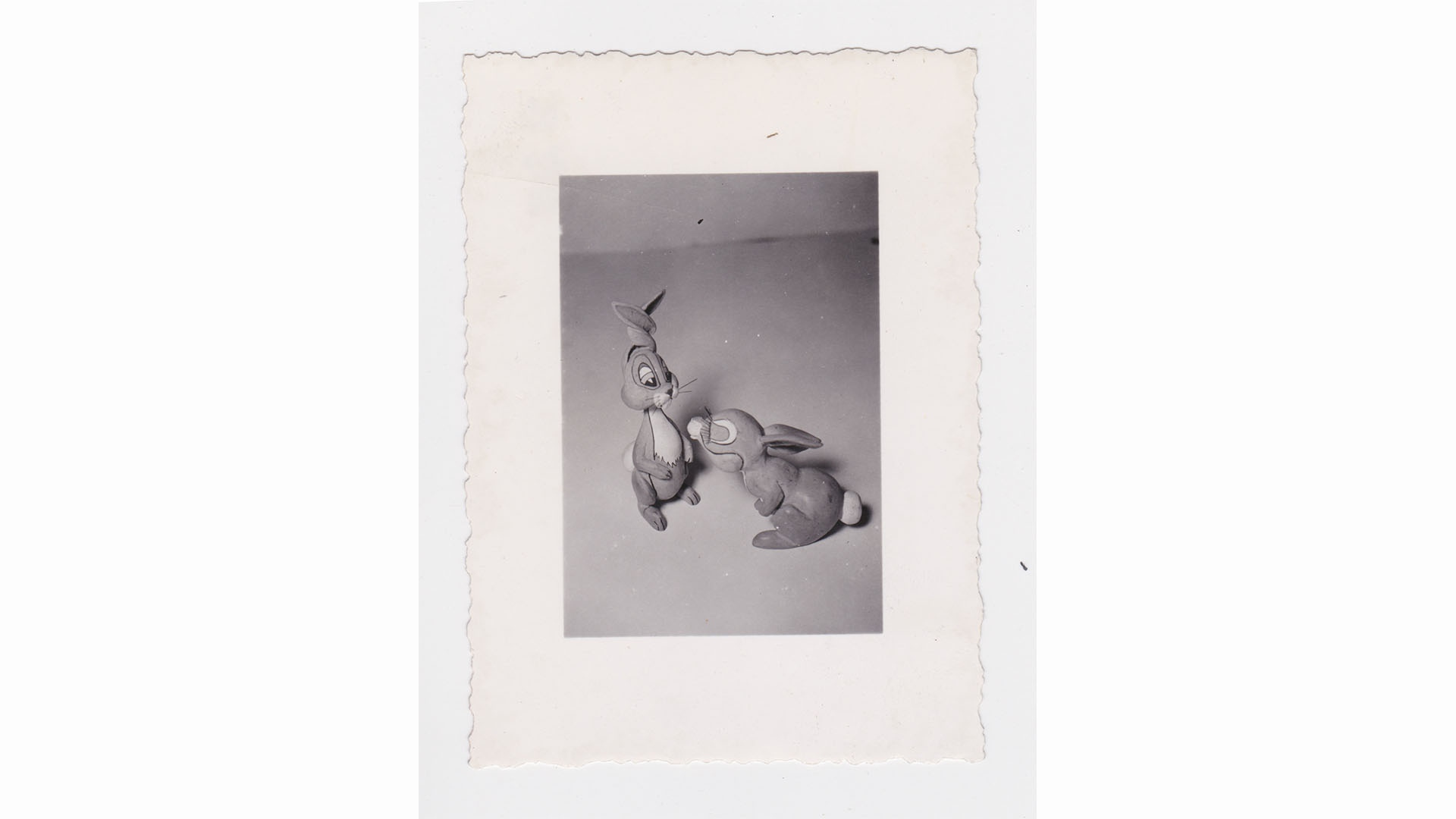The Homeland Issue
Half-Life
Waste and romance in a landscape of fear
WASTING IN FEAR — In February 14, 2014, a 208-liter drum of radioactive waste exploded at the Waste Isolation Pilot Plant (WIPP) in New Mexico. The deep geological repository adopted the 250,000 year-old Delaware Salt Basin to cradle and contain waste from nuclear weapons research and production more than 600 meters below the surface. Radioactive material from the 2014 incident traveled through the ventilation system of the plant, exposing 21 workers to dangerous radiation, and called to question the reliability of the waste fortresses inhabiting the New Mexico nuclear corridor. After extensive investigation, the cause of the explosion was ultimately determined to be due to the fact that the radioactive refuse was packed with organic cat litter, rather than clay cat litter.
Dear Grandma and Grandpa,
It’s been so long. I’m writing to tell you that I visited Gila River. I’m sure this is hard for you to read, as we never talked about the internment camps when I was younger. Maybe it’s because I was too young or maybe it’s because the past is too much to carry.
I feel strange describing what I saw because you lived at Gila for far too long. The sun, the dirt and the land seemed so barren and forever that even outside the barbed-wire fence, the idea of freedom melted in with the evaporating horizon. Concrete foundations still remain with some bearing messages carved into them, hearts with indistinguishable names, or “Home Sweet Home.” Do you remember any of these?
It reminded me of the tree we all used to climb in your backyard as kids. “Hide + Sue” inscribed into the bark, embraced by carved channels shaping a crooked heart. I imagined Grandpa at camp guarding the water tower, looking beyond the barracks, carving your name into the wooden figurines he made for you during those years. How many did he make you? We have so many at home, but sometimes I wonder if any stayed behind.
I fantasized about finding one during my visit, buried in the dirt along with the concrete, rusted washing cans, shoe soles, and other debris left to meld with the dust. I imagined my hands picking up the rotting wood, delicately handling the legs of a time-eroded fi gurine. Those names, slabs and rust will stay there forever, even lifetimes from now when it is all entombed in the earth like an ancient city. Although the time was painful, we can’t submit to the amnesia of the future.
I’m hoping to return to Gila River. I’ll be sure to write you again.
Love, Alex
The half-life of U-238, the main uranium component extracted from yellowcake, a concentrate of uranium taken from the Earth’s ore, is approximately 4 billion years. For weapons and fuel, the U-238 is enriched through isotope separation to increase the level of U-235, the only nuclide that exists in nature (predating Earth) that can sustain a nuclear fission reaction. The waste accrued from spent fuel or reprocessing of nuclear material inhabits spaces like the Delaware Basin with a half-life ranging between 200,000 to 15 billion years, depending on the particular form of the waste.
Radioactive material retains its voracity for devastation as long as its shelf life. Uranium mining began in the Colorado Plateau, Navajo land, in order to obtain yellowcake. Lacking the ability to reintegrate symbiotically with the environment, the waste is buried in facilities like the WIPP — a deep geological memory we won’t have the ability to forget. It is an undying byproduct from half a century’s conquest to manipulate the atom for national security and, subsequently, American nuclear hegemony.
Nuclear practice is big business in the United States, with the government continuing to contract multiple corporations to pour more cement and lay more steel to accommodate for more canned death. Preparation for facilities like WIPP and the forthcoming Yucca Mountain facility (a similar nuclear disposal site in nearby Nevada) involve years of construction, road and highway expansion, and other efforts to reshape geographical and political spaces in the region. But it is not only dollars that are produced in this capitalist terrain, it’s also images of hegemonic power. These types of disposal programs employ the local population and encourage scientific leaps for environmental protection. With the WIPP’s scheduled internment somewhere between 2025-2035, hypothetically isolating the hazardous waste from the environment, we are promised safety — or at least, an image of safety, from its potential effects. All the while, the radioactive material remains below, living, waiting and incubating in a deadlock of concrete and salt. No longer an external byproduct, the material will integrate into the strata of time and the Earth will turn to waste.
The soil of the American Southwest is rich with a historic practice of waste disposal, nuclear and then some. In March 1942, the then-U.S. Commissioner of Indian Affairs, John Collier, proposed that the Department of Interior should oversee the relocation of Japanese Americans on Pima and Maricopa native land. Collier hoped that the Department of Interior’s experience and resources would benefit the Native community with reclamation and agricultural projects executed by the internees, and stimulate employment for the Native community to work as guards or social workers at the camps. The proposal was ultimately accepted, and the War Department chose two sites in the Gila River Indian Community and the Colorado River Indian Community to host two relocation camps. This decision did not pass without conflict, as local Tribal Councils from both reservations moved to take a community vote to decide whether the reservations would host the camps. Their efforts were ultimately denied by the Office of Indian Affairs and a five-year lease was given to the U.S. War Relocation Authority.
The Japanese internment camps pose a unique form of waste and containment in the American Southwest. Its existence is accompanied by other similar histories, as it is not the only one of its kind. Land expropriation and incarceration are embedded in historical spaces like the Navajo’s Long Walk to Bosque Redondo, or land seizures for uranium mining in the Colorado Plateau. With the layering of violence and repression in this region, Japanese-American internment on Native Land is, to me, a continuation of waste practice orchestrated and perpetuated by colonial America. This waste was not produced by a machine, nor can it be stored in a 208-liter drum. It was propagated by administrations of fear in American society. Like the drums buried in the Delaware Basin, the body-as-waste retains itself as an economic necessity for the capitalist machine through timeless images and rhetoric. Prisoners are embodied as socialized waste — outcasts, savages, Japs, “the Other.”
Both radioactive material and human waste are the troublesome refuse of American fear and spaces of American violence. The face of the villainized Other incites fear and virtuosity in the consumer, which fuels the gears of righteous capitalism. Hatred for the incarcerated face incites land to be cleared and taken, war bonds to be bought, and bombs to be dropped; meanwhile, the bodies of prisoners, waste products of fear and living breathing beings, are corralled and left idle behind barbed wire fences until further notice. The barrels of uranium are the receipts of America’s military-industrial greed; the triumphs of unearthing the horrors of yellowcake now returned to the soil, unable to sleep.

WASTE AS INFINITE TIME
Where will I be in 80 years? My answer is “nowhere.” I will have returned to the mud through the generosity of insects, or my body will be disintegrated to ash. My very biology calls for my end; born to grow, love, hate and deteriorate. This is what we may think of as a natural life-cycle. However, the ecology of the earth is transforming. Some call it the Anthropocene. Some call it the Capitalocene. I call it a hot mess. Humans parade hypocrisy, earnestly striving to extend our lifetimes while continuing to diminish natural resources, poison the water or introduce toxins into the atmosphere. Obsessed with the luxury of the present, time has been forgotten for gasoline, palm oil, and the dreams of everyday life. Capitalism and history butcher the beauty of time, exploiting its incomprehensible measure to catalyze social amnesia; hoping that Earth will conceal documents of violence in the dust and that people will inherit incomplete narratives of the past. People may comply to the erasure of trauma, but the land never forgets.
We bury the waste today so we can forget it tomorrow. We violently condemn the innocent so our neighborhoods are safe today. Both practices of nuclear waste and Japanese-American incarceration present different forms of time that were skewed by administrations of fear. Both present a transformation of natural time by leaving ruins like the WIPP or relocation camps to the forces of nature, hoping we can forget. Instead, the substances remain fossilized in the soil- a stratum of nightmares in the Earth with thousands of years of annihilation brewing in its long life. Not only do these actions inhabit a geological time, but a social memory within history. What will happen to the memory of posters ordering the Japanese to leave their homes? A trail of documents record the narratives we’ve sewn into history. Maps are redrawn, stories are retold and history unfolds. Violence, waste and repression provoke new spaces of time to sprout in the historical tale.
History, with politics as its sidekick, has its ways of concealing these stories in shadow. The salt of the Delaware Basin will eventually fill the cracks that echo the whispers of so much canned death. The cacti endure the hell of the sun and trees and weeds will consume what remain of concrete foundations which were once beds to Japanese internees. The dust ravaged in the wind and then settled to bury the footsteps of the Navajo. In the meantime, America continues its arms race, unjustly incarcerating bodies and condemning innocent civilians of domestic and international communities to their graves.
Bodies can be buried, along with steel drums of death and the concrete fragments of internment camps where my family was held. But violence and its waste can never disappear, and if it seemingly does, it is because people forget. Although solutions to rectify have been proposed by the State, power and history are indebted to systems of neglect to wash the slate clean. Monuments are built, seldom maintained, and a short chapter is written in a textbook. But Earth finds a way to remember, fossilizing our actions, desires and vices into geological strata and social memory. The waste of fear embodies an incomprehensible span of time that is both a scientific object and a cultural image. A 15 million year half-life sure as hell feels like forever. The cultural imaging of these wastes (nuclear fallout, Native genocide, Japanese imprisonment) sustains a memory that remains unchanged through the generations, travelling through time like a neglected prophet that’s come too late.
Even at the WIPP, signs and symbols were researched with anthropological teams to warn future sentient life of the immense danger we left behind. “Stay away!” the symbols scream. But events of violence have passed. What remains is waste as the document of trauma and a history with the potential to inspire redemption. And though our potential for forgiveness or redemption remains in question, the looming presence of death remains infinite in the earth, exceeding our time and into the next.

PUPAE OF THE FUTURE
When my grandfather was held at Gila River Relocation Center, he spent most of his time carving small wooden figurines for my grandmother using a pocket knife he snuck into the camp. The figurines took different forms, predominantly animals, flowers or blocks of letters. The figurines were one of a few modest gestures he could pass to her in the wastelands of Arizona; a romance in the face of extinguished justice and global chaos.
These too are the fossilized remnants of the Southwest’s past left to the effects of time. These objects, however, differ from the drums of uranium or the socialized waste of bodies. The figurines, along with other infrastructures built by those interned in the camps (gardens, monuments, koi ponds, baseball fields, schools, dance-halls) are an unexpected offspring of the waste of our nation’s fear. Transforming and drawing energy from tradition, history, and violence, the figurines are hybrid spaces of experience; pupae of entanglement. They are memories of the future, for the future. The beginnings of hope and resistance. They are the vessels for an infinitely unfolding mutation; a chrysalis for change born from overwhelming violence. Not only bound to physical media, the languages of collaboration, construction, formation, deformation and even romance constitute these pupae of entanglement, constantly revolting against systems of power through its amorphous biology, fueled with the persistence of an unforgiving memory. The biology is tumultuous, fluid as the ocean and elusive like a cloud. It is on edge, unpredictable, and rightfully so, in order to endure and combat institutions of violence that undeviatingly deem bodies not human.

But what could this do to change the catacombs of death buried in the New Mexico desert, the weapons pointed to the sky, or the bodies taken and jailed in their sleep? How can a pupa defy the cold of steel? For that, I do not have a clear answer. These pupae I describe do not conform to scientific time, order or measure. They disappear and reappear, advance and then hibernate. In most cases, they may be met with opposition as, being the offspring of waste, they present the face of the Other. But although seemingly uncontrollable and immeasurable, they are formed by and serve the dispossessed and disenfranchised. They inhabit social justice movements, immigrant lives, riots, dance halls, teenage angst – aberrations of hope in the a landscape of fear.
Alex Ito is a New York-based artist living and working in Brooklyn. His work has been displayed at Baltimore’s Springsteen Gallery, AALA Gallery in Los Angeles, the Still House Group in Brooklyn, and many others. Find his work at http://alexitostudio.com/.
“Gila River War Relocation Center” by Tony Santiago is licensed under CC BY-SA 4.0.
All other images courtesy of the author.